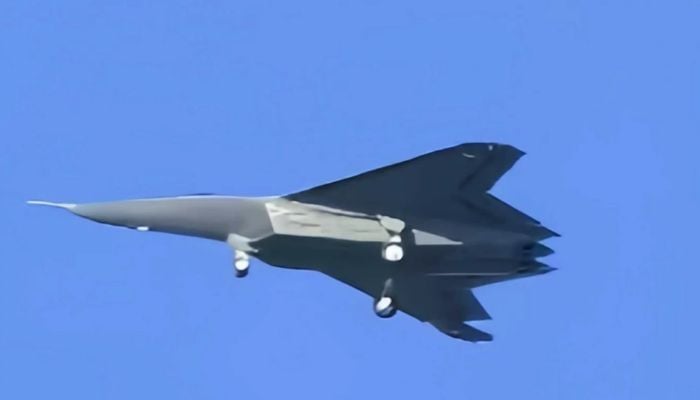Chinese J-50's first glimpse signals move towards air superiority
Experts believe China’s sixth generation fighter jet project could reach operational stage by 2030
April 07, 2025

- China’s Shenyang Aircraft Corporation reportedly develops aircraft.
- J-50 has been designed solely for stealth, AI-enabled, high-speed networked warfare.
- Aircraft's aerodynamic structure appears inspired by technology of F-22 Raptor, B-21 Raider.
ISLAMABAD: In what experts believe is a sign that China is now moving towards superiority in the air, sea, and cyber domains, the first clear glimpse of China’s sixth-generation fighter aircraft, the J-50 has been revealed to the world.
China’s Shenyang Aircraft Corporation (SAC) is reportedly developing the aircraft.
According to Indian media reports, analysis of satellite images has made it clear that China is now preparing to openly challenge American air superiority.
According to IDRW reports, the J-50 is a fighter jet designed solely for stealth, AI-enabled, high-speed networked warfare. According to experts, it will not just act as a warplane, but as a ‘flying war command centre in the air’.
Experts believe China’s sixth-generation fighter jet project could reach operational status by 2030, but current developments suggest that China wants to prepare this jet for induction as soon as possible.
Its name is J-50 Shenyang, meaning “Divine Shadow”. This name reflects the strategic thinking behind this fighter jet, implying an invisible shadow that can penetrate enemy territory and wreak havoc.
The biggest feature of the J-50 fighter jet is its full spectrum stealth design, which enables it to hide not only from radar but also from infrared, electronic, and even some AI-detection systems.
Its aerodynamic structure appears to be inspired by the technology of the F-22 Raptor and B-21 Raider. Moreover, this fighter jet comes with AI-powered swarm drone command: The J-50 can not only fight alone but also guide a swarm of drones.
Experts speculate that this jet could be equipped with missile systems like the DF-ZF hypersonic glide vehicle or KD-21. Reports also suggest that this fighter jet is being designed to integrate quantum radar and directed energy weapons.
Additionally, this jet can be fully plugged into China’s integrated theatre command system, turning it into an ‘airborne brain’ on the battlefield.
China’s J-50 stealth fighter jet is designed specifically to challenge America’s F-22 and the future NGAD sixth-generation fighter jet programme.
The US announced the NGAD fighter jet programme last month and assigned Boeing the responsibility of developing this fighter jet. Notably, China could use this jet to establish dominance in the South China Sea, Taiwan Strait, and the Indian Ocean region.
According to reports, this poses a serious threat to both India and the United States.
For India, the biggest threat from this fighter jet could be seen in Arunachal Pradesh and along the Line of Actual Control (LAC).” Compared to India’s Su-30 MKI and Rafale fighter jets, the Chinese J-50 aircraft will be significantly more advanced in terms of technology.
In addition, the range and stealth capabilities of the J-50 aircraft can target the US Indo-Pacific bases and carrier strike groups. This further strengthens China’s ‘Anti-Access/Area Denial’ (A2/AD) doctrine.
According to reports, China is currently working on an ‘Integrated Deterrence’ strategy, which combines economic, military, and cyber strength to severely defeat enemies on the battlefield.
The J-50 fighter jet is part of this strategy. This aircraft sends the message that China is no longer just a defensive country but has become one that can project power. The testing of the J-50 has been kept secret, and the sudden leak of its footage and satellite views is considered part of China’s ‘psychological warfare’.
Experts believe that the leak of images of the J-50 fighter jet signifies not only a technological leap but also a geopolitical warning. China is now moving towards superiority in air, sea, and cyber domains.











